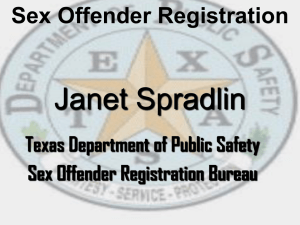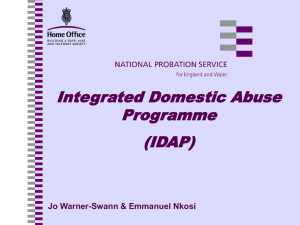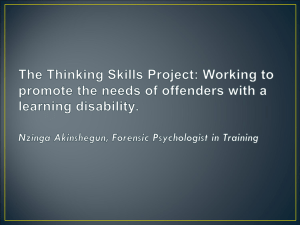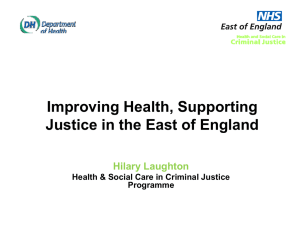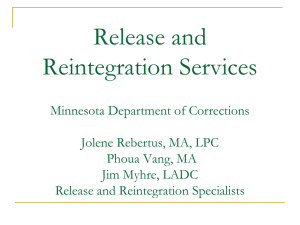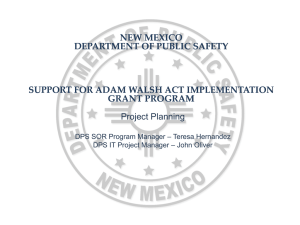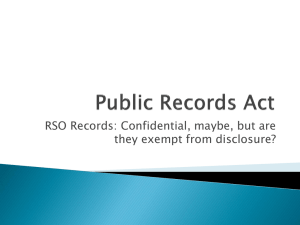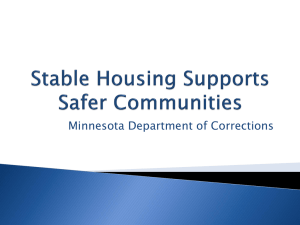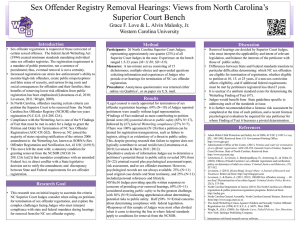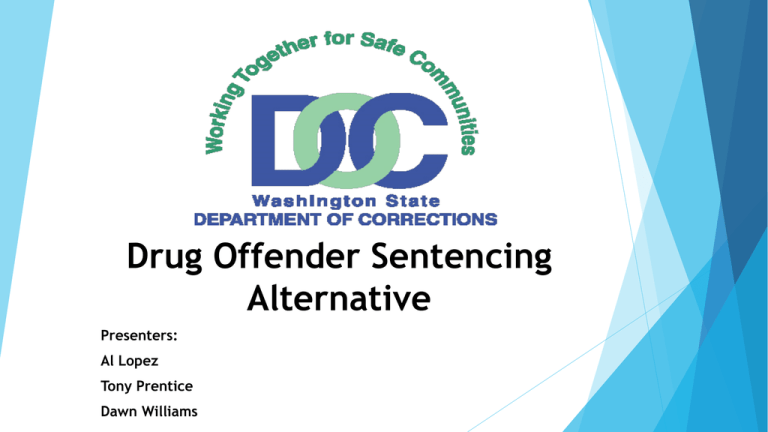
Drug Offender Sentencing
Alternative
Presenters:
Al Lopez
Tony Prentice
Dawn Williams
Drug Offender Sentencing Alternative History
Year of DOSA Legislation
Legal Requirements
Current felony conviction
1995
1999
2005
Manufacture, delivery or
possession with intent to
manufacture/deliver a
controlled substance
Criminal attempt, solicitation,
or conspiracy to commit these
crimes.
All felonies, with
exception of violent
or sex offenses.
All felonies, with exception
of violent or sex offenses.
No violent or sex offenses
within the last 10 years.
Cannot have served a DOSA
Sentence within the last 10
years.
Not subject to deportation
detainer or order.
Prior felony conviction
No prior felony convictions.
No violent or sex
felonies.
Immigration
No requirements
Sentence length
Midpoint of standards range
greater than 12 months.
Not subject to
deportation detainer
or order.
Standard range
greater than 12
months.
Community
supervision/Revocations
1 year community custody;
court may revoke.
Remainder of
sentence on
community custody;
DOC may revoke.
For “prison-based”
alternative, standard range
great than 12 months. For
“community-based”
alternative, two years on
community custody, or half
the midpoint of the
standard sentence range,
whichever is greater.
Remainder of sentence on
community custody; DOC
may revoke.
Supervision for community
DOSA by Court
Drug Offender Sentencing Alternative (DOSA)
Prison and Residential
An offender is eligible for the special drug offender sentencing alternative if:
(a) The offender is convicted of a felony that is not a violent offense or sex offense and the
violation does not involve a sentence enhancement under RCW 9.94A.533 (3) or (4);
(b) The offender is convicted of a felony that is not a felony driving while under the influence
of intoxicating liquor or any drug under RCW 46.61.502(6) or felony physical control of a
vehicle while under the influence of intoxicating liquor or any drug under RCW 46.61.504(6);
(c) The offender has no current or prior convictions for a sex offense at any time or violent
offense within ten years before conviction of the current offense, in this state, another state,
or the United States;
(d) For a violation of the Uniform Controlled Substances Act under chapter 69.50 RCW or a
criminal solicitation to commit such a violation under chapter 9A.28 RCW, the offense involved
only a small quantity of the particular controlled substance as determined by the judge upon
consideration of such factors as the weight, purity, packaging, sale price, and street value of
the controlled substance;
(e) The offender has not been found by the United States attorney general to be subject to a
deportation detainer or order and does not become subject to a deportation order during the
period of the sentence;
(f) The end of the standard sentence range for the current offense is greater than one year;
and
(g) The offender has not received a drug offender sentencing alternative more than once in the
prior ten years before the current offense.
Prison Based and Residential DOSA
(3) If the sentencing court determines that the offender is eligible
for an alternative sentence under this section and that the
alternative sentence is appropriate, the court shall waive
imposition of a sentence within the standard sentence range and
impose a sentence consisting of either a prison-based alternative
under RCW 9.94A.662 or
a residential chemical dependency treatment-based alternative
under RCW 9.94A.664. The residential chemical dependency
treatment-based alternative is only available if the midpoint of the
standard range is twenty-four months or less.
DOSA Continued
(4) To assist the court in making its determination, the court may order the department to complete
either or both a risk assessment report and a chemical dependency screening report as provided in
RCW 9.94A.500.
(5)(a) If the court is considering imposing a sentence under the residential chemical dependency
treatment-based alternative, the court may order an examination of the offender by the department.
The examination shall, at a minimum, address the following issues:
(i) Whether the offender suffers from drug addiction;
(ii) Whether the addiction is such that there is a probability that criminal behavior will occur in the
future;
(iii) Whether effective treatment for the offender's addiction is available from a provider that has
been licensed or certified by the division of alcohol and substance abuse of the department of social
and health services; and
(iv) Whether the offender and the community will benefit from the use of the alternative.
(b) The examination report must contain:
(i) A proposed monitoring plan, including any requirements regarding living conditions, lifestyle
requirements, and monitoring by family members and others; and
(ii) Recommended crime-related prohibitions and affirmative conditions.
DOSA Continued
6) When a court imposes a sentence of community custody under this section:
(a) The court may impose conditions as provided in RCW 9.94A.703 and may impose other affirmative
conditions as the court considers appropriate. In addition, an offender may be required to pay thirty dollars per
month while on community custody to offset the cost of monitoring for alcohol or controlled substances.
(b) The department may impose conditions and sanctions as authorized in RCW 9.94A.704 and 9.94A.737.
(7)(a) The court may bring any offender sentenced under this section back into court at any time on its own
initiative to evaluate the offender's progress in treatment or to determine if any violations of the conditions of
the sentence have occurred.
(b) If the offender is brought back to court, the court may modify the conditions of the community custody or
impose sanctions under (c) of this subsection.
(c) The court may order the offender to serve a term of total confinement within the standard range of the
offender's current offense at any time during the period of community custody if the offender violates the
conditions or requirements of the sentence or if the offender is failing to make satisfactory progress in
treatment.
(d) An offender ordered to serve a term of total confinement under (c) of this subsection shall receive credit
for any time previously served under this section.
(8) In serving a term of community custody imposed upon failure to complete, or administrative termination
from, the special drug offender sentencing alternative program, the offender shall receive no credit for time
served in community custody prior to termination of the offender's participation in the program.
(9) An offender sentenced under this section shall be subject to all rules relating to earned release time with
respect to any period served in total confinement.
(10) Costs of examinations and preparing treatment plans under a special drug offender sentencing
alternative may be paid, at the option of the county, from funds provided to the county from the criminal
justice treatment account under RCW 70.96A.350.
Department of Corrections Treatment
Services
DOC Services are provided:
11 of the 12 Prison facilities
13 Work Release Facilities
21 Community Supervision sites
Contracted services are provided:
American Behavioral Health Systems (ABHS) in Chehalis and Spokane
27 contracted providers delivering services in rural areas
Pioneer Center East and North
Specialized DOSA Calendars
Spokane County
King County (Seattle)
Clark County
Snohomish County
Kitsap County
Whitman County
Skamania County
Therapeutic Communities
Services for Residential DOSA offenders are provided at ABHS for 90 to 180
days
Services for Prison-Based DOSA offenders are provided in 11 of the 12 prison
facilities and include Therapeutic Communities at 3 locations and Intensive
Day Treatment, Intensive Outpatient Treatment and Co-Occurring Intensive
Outpatient Treatment
Services for both Prison and Residential DOSA offenders are provided in the
community upon release from ABHS or Prison and consist of Intensive
Outpatient, Enhanced Day, Outpatient, Co-Occurring treatment modalities
All DOC treatment services are delivered with strict adherence to the lesson
plans and manuals.
Therapeutic Community Definition
“A therapeutic community is a drug-free environment in which people
with addictive (and other) problems live together in an organized and
structured way in order to promote change and make possible a drugfree life in the outside society. The therapeutic community forms a
miniature society in which residents, and staff in the role of
facilitators, fulfill distinctive roles and adhere to clear rules, all
designed to promote the transitional process of the residents” (
Ottenberg 1993)
Therapeutic Community History
1946 “The hospital as a therapeutic institution” was coined by Thomas Martin
in the Britain.
Therapeutic communities (in Britain) became increasing more popular towards
the end of World War II and the concept of therapeutic community took hold
and became dominate in the field of inpatient psychiatry throughout the
1960’s.
Synanon was founded in 1958 in California by Charles (Chuck) Dederich
Daytop Village and Phoenix House were early TC programs that were
influenced by the Synanon model.
In the late 1960’s within the US Correctional system, the Askelpion Foundation
initiated therapeutic communities in the Marion Federal Penitentiary.
House of Thought in Virginia Correctional systems was established in 1974 and
was able to demonstrate a reduction of 17% recidivism for those offenders who
participated in the program for more than 1 year.
Community Terminology Pg. 27-31
Acting as if: To assume a role or attitude even though you are not comfortable or do
not want to, but acting “as if” you do. It is a basic TC concept instructing
Community members and staff to behave as the persons they should be
rather than the person they have been.
Agent of Change: Participation and involvement link the
Community as a method to the individual in the change process.
Participation is the key contribution each Community member makes in the
process. It is the Community’s continual assessment of, and responses to,
the Community member’s participation and level of involvement that
maintains them in this process. The agent of change is the Community.
Community Terminology Pg. 27-31
Awareness: (verbal/written) Alerting others of negative selfdestructive/defeating behavior. A sign of respect and responsible
concern.
Brothers/Sisters Keeper: Community members are taught by their peers
to listen respectfully to upper phase members and to accept verbal
feedback and guidance from them. The credibility of upper phase
members comes from their Community status as role models; they are
examples of positive personal change and teach and keep others
accountable.
Community Terminology Pg. 27-31
Confrontation: Offering a person a description of his behavior and its effects on
others with a request that they explain and/or change it, without intimidation.
Representing self, not defending self. Speaking in a calm, smooth, rational and
respectful manner.
Community Meeting: As used in this handbook is a general term referring to any
formal meeting occurring in the Therapeutic Community.
Community as a Method: This means teaching individuals to use Community life
to learn about themselves.
Denial: Being defensive, minimizing the seriousness of a problem
Community Terminology Pg. 27-31
Feedback: Response or reaction to something another person has done or
said. The term is used most often in a context indicating that the response is
constructive in intent. Negative feedback is criticism (condemnation).
General Meeting: Response to behavior(s) that seriously endanger the
Community, e.g., cardinal rule violations. A meeting held in response to a
“crisis” in the Community.
House Meeting: Is generally conducted at the end of the work week during a
PM meeting and is a time for staff and Community members to close out the
week’s business and transition into the weekend.
House Rules: Keep the Environment of the Community Safe. House
expectations include: quality job performance, how Community members
address each other, standing if you get sleepy in a group activity, appropriate
use of phones, etc.
Community Terminology Pg. 27-31
Interaction Tools: Progressive Steps of interaction used to assist Community
members in awareness and changing self-defeating, self-destructive
behaviors.
Learning Experience (LE): An assignment given to a Community member for
exhibiting self-defeating, self-destructive behaviors in order to provide an
opportunity to change that behavior.
Line of Communication: Within the Community, the formal communication
pathway is vertical. Information is passed in a prescribed order, top down to
the crew members and from crew members up to SOD.
Manipulation: Definition (Webster): controlling someone else by unfair or
indirect means, to entrap for one’s own advantage, e.g., negative contracting
Community Terminology Pg. 27-31
Major Rule: Standards and Boundaries - These are behavior
expectations that govern how people will interact with each other and
expectations about how they go about their daily lives in the TC.
Examples include: no lying, no disrespect, and no profanity.
Minimizing: To downplay problems and not be responsible or
accountable in owning self defeating behavior.
Negative Contracting: Two or more people agree to have a secret
contract not to disclose or confront one another.
Orientation Session - Transition: (Phase One) Study time used to
review model history, handbook, procedures.
Community Terminology Pg. 27-31
Peer Accountability: Members respectfully make each other aware of negative
behavior(s), in an effort to bring about positive change in behaviors and attitudes.
Personalizing: Tendency to incorrectly think the actions or statements of others
are a personal attack; thinking it is all about you
Posturing: A negative position or attitude of the body (e.g., threatening,
intimidating).
Playing it Safe: Doing just enough to get by, with no major change in thinking or
behavior.
Processing: Discussing the dynamics of what has occurred in order to discover the
how and why of events, feelings and behaviors. This helps improve the
effectiveness of the treatment process.
Community Terminology Pg. 27-31
Projection: Seeing offensive characteristics in others that are really present in us, e.g.,
finger pointing. Its purpose is to protect us from admitting our own faults. A defense
mechanism in which one attributes one’s own unacceptable or unwanted thoughts
or/and emotions to others.
PROPS: Proper Respect Of People . PROPS is called when a Community member is
talking and other members are not listening, speaking out of turn, interrupting, or
behaving in an inappropriate, disrespectful manner. PROPS may be called by either
staff or Community members during meetings, groups, or educational lectures when
members are acting improperly. Sitting in PROPS means sitting with your feet on the
floor, no crossing of legs, hands on knees, back straight, shoulders back, listening
attentively, with eyes on the subject. Relaxed PROPS means sitting back in your chair,
feet on floor with hands in a comfortable, appropriate position being attentive to what
is occurring.
Community Terminology Pg. 27-31
Proposal: Ideas from individual members, crews, or the Community brought to the
staff on duty (SOD) concerning Community business, which uses a defined written
format and goes through the proper line of community
Pro-Social: Following the healthy behavior expectations and norms of the dominant
society. Following and living the guidelines of Therapeutic Community.
Push Ups: Acknowledging a Community member “doing something right,” above and
beyond their normal call of duty or behavior. Not just “being a friend,” but going
outside their job description to help others or the Community without being asked.
Doing the right thing when you don’t think anyone knows or is looking, giving back
without expecting anything in return.
Rational Authority: All professional staff, to include DOC, contract, and volunteers.
Rationalization: An attempt to justify one’s behavior by thinking up “good” reasons
for it. Excuses are forms of rationalization. It proves that my behavior is “rational,”
normal, and justifiable, and therefore worthy of approval. In short, it is excuse
making. This removes responsibility from me.
Community Terminology Pg. 27-31
Reacting: An impulsive expression of feelings, either verbal or nonverbal, in an inappropriate place and manner.
Reflection : 1) careful thought or consideration; 2) to think seriously;
to ponder or consider; 3) a thought, idea, or opinion formed or a
remark made as a result of meditation; 4) consideration of some
subject matter, idea, or purpose, e.g. People do that sort of thing
every day, without ever stopping to reflect on the consequences.
Relating Table: This form of interaction is practiced for conflict
resolution, and is utilized when the disagreement is between two
Community members to help learn healthy communication, social and
problem solving skills.
Community Terminology Pg. 27-31
Seminar: A seminar is an informal educational lecture (may be a learning
experience) conducted by a Community member which helps to broaden the
members’ scope of awareness and information, and exercise the mind. The focus of
the seminar is Recovery based and can be on any subject or current event, and can
express different viewpoints and opinions. The speaker must be sure to thoroughly
research the subject material. The content must be factual, clear, comprehensive,
and must receive prior approval from staff. This experience also teaches public
speaking skills to the Community members who present a “seminar.”
Sidebar: When two or more people are having any conversation, written, verbal, or
no-verbal, while someone else is talking, to the point of distraction and disrespectful
behavior.
Structure Board: Large organizational chart that provides a snapshot of the overall
hierarchy in the Community. It summarizes job functions, levels of responsibility, and
lines of communication.
Structured Movement: The term structured movement refers to the organized and
coordinated movement of Community members in a single-file or “column of twos.”
Sub-grouping: A distinct group within a group.
Community Terminology Pg. 27-31
Social Learning: A lifestyle change occurs in a social context. Negative
patterns, attitudes, and roles were not acquired in isolation, nor can they be
altered in isolation. Thus, recovery depends not only upon what has been
learned, but how and where learning occurs.
Spirituality: (Spirit) A person’s essential nature. The part of the human being
associated with the mind and feelings. A person’s personal belief and value
system.
DOC
--------------------Staff on Duty
SOD
Senior
Coordinator
Senior Clerk
Leaders in the
Community
Assistant
Coordinator
LEAD
LEAD
LEAD
LEAD
LEAD
Education Crew
Motivation
Crew
Energizers
Birthdays
Graduations
Phase
promotions
Support groups
Recreation
Leisure
activities
Business Crew
Environment
Crew
Dorm
inspections
Cleaning
inspectors
Beautification
Environmental
issues
Service crews
Expeditor Crew
Tutors
Translators
Learning
experiences
Word and
thought for the
day/week
Co-facilitators
Seminars
Education
Accountability
Media
communication
Structure board
Newsletters
Employment
Business office
Peer
Mentor
Sign-in sheets
Time keepers
Program room
and Community
meeting set ups
Norms and rules
Roll call
Resident
tracking &
location
LEAD
Orientation &
Re-Entry
Crew
Welcome new
Community
members
Mentors
Community
Reps
Organizes reentry initiatives
Support and
housing
opportunities
for members
Line of Communication: Within the Community, the formal communication pathway is vertical. Information is passed in a prescribed order, top down to
the crew members and from crew members up to SOD.
What is it about right living that you cannot support ?
Common beliefs, shared
norms and values serve as
explicit guidelines for
teaching right living.
Rules, regulations and
community norms protect
the physical and
psychological safety of the
community.
Common language
Structure and accountability
You are your brothers keeper
Purpose of a TC Pg. 7
The primary goal of the Community is to provide
members with a sense of belonging, acceptance, and
new skills for living without self destructive behavior
patterns.
The Community is a highly structured environment with
a specific moral and ethical code of conduct.
It uses Community-imposed steps of interaction, earned
advancement and privileges all of which are part of
recovery personal growth.
Being part of something greater than oneself is an
especially important part of recovery from a criminal
life style.
Purpose of a TC Pg. 7
The Community helps its members develop attitudes, behaviors, and lifestyle
changes that will enhance and maintain recovery from addiction, criminal
behavior, and other destructive behaviors.
Members and professional staff work together to support the Community and
the Community itself is the vehicle by which members gain personal insight
and positive change.
TC Expectations Pg. 8
Therapeutic Community is about living right. To live right means there is a
healthy standard of behavior that is expected from each Community member.
Community expectations extend beyond observance of the rules of conduct.
They define the member’s participation and integrity in the Community, and
their involvement in the process of change and recovery.
Out of respect Community members observe each other’s participation in all
the activities and roles of the Community, as well as how they use these
activities and roles for self-change. Community members need to respect
others and be concerned for the health of the Community.
How can change be expected if the need to change is not respectfully
brought to one’s attention? When people respect each other they accept the
responsibility of helping each other to grow and change in positive ways.
Through the act of bringing self-destructive behaviors to another’s awareness,
the need for change is identified and the choice for change can be made
through:
TC Expectations Pg. 8
Performance: As members move through the TC, Community expectations
increase as demonstrated behaviors improve. Focus and personal efforts are
expected to move toward a higher and consistent level of performance.
Responsibility: As Community members move through the TC phases, the
Community expects an increase in responsibility and accountability. As
members assume responsibility for their own behavior and choices, they will
extend responsibility beyond self to their immediate peers, and finally to the
entire Community.
Self-examination: Is self-awareness and self-disclosure as it relates to
personal change. Focus shifts from a more self centered view to a greater
world view and an increased appreciation or interdependence and strength of
the Community
Self-sufficiency: True self sufficiency and independence occur when
individuals adopt positive changes internally regardless of outside influences.
Independence increases as new behaviors are practiced and are used to help
self and then others.
Personal Goals For Community Living Pg. 11
To use the time in prison in a positive manner
To gain an understanding of myself, mentally and emotionally
To gain an understanding of my self-destructive, self defeating behaviors
To prepare myself for successful re-entry into society
To build my self-esteem by respecting others and myself
To learn how to express myself in a positive and appropriate manner
Personal Goals For Community Living Pg.
11
To learn about self-help and how it applies to me
To gain an understanding of others
To learn how to become pro-active, rather than reactive
To learn the importance of being responsible and practice doing so
To gain a sense of positive direction in life
Social Learning Process Pg. 18
The Social Learning Process
A lifestyle change occurs in a social context (a community).
Negative patterns, attitudes, and roles were not acquired in isolation, nor can they be
altered in isolation. Thus, recovery depends not only upon what has been learned but how
and where learning occurs.
Criminal behavior is learned, it can be unlearned.
This is the basis for the Community itself, serving as teacher. Community is the method
of change.
Learning is active: by doing and participating.
The Community initiates change in the individual. With its focus on social participation,
mutual responsibility, and relationships based on respect and the values of right living, the
Community provides the opportunity for developing healthy and appropriate behavior to
include:
being a role model for others,
advancing in the work structure and Community hierarchy,
progressing through the phases of the model, and
relating in new ways to Community members and staff.
The Agent of Change Pg. 27
The community itself is the agent of change
Treatment counselors, DOC , mental health staff or families
are not the agent of change
In a Therapeutic Community, we learn that recovery can
only come from within
COMMUNITY
TC programs also view themselves as families, or rather surrogate families that correct
historical injuries from the dysfunctional families of the offenders they serve.
The TC strives to sustain the main characteristic of the “good family” including:
1.
Structure, to provide order in daily living through physical and psychological safety.
2.
Individual acceptance and encouragement, conditional only upon honest participation
in the struggle to change.
3.
Transmission of values through a daily regimen of activities for social learning.
Elements of a Therapeutic Community
The proposal and approval process (Page 60)
1.
Ideas from crew members or community
2.
Relating to any community business
3.
Formal process and written format
4.
Brought to the SOD through lines of communication
5.
Approved by Rational Authority
“Staff On Duty” (page 37) is the person responsible for handling the daily
business of the community including member accountability, approval of
requests and issues that occur within the community.
The SOD is the contact staff for the Senior Coordinator/Designee and speaks
for the community to Rational Authority. This is where the communication
begins and ends for the community.
Real Colors
Colors presentation.


